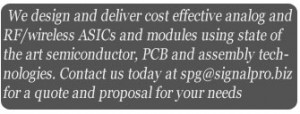We have divided the ASIC types that we develop into two categories. These are the miniASIC and the macroASIC. This nomenclature applies to the functionality, size, complexity, cost and risk of the device. A miniASIC is a device with very few elements on it. It is small in size ( remember size differentiation; 50 mils on a side is small, 100 mils on a side is medium and 250 mils+ on a side is large for analog, RF, wireless or mixed signal ASICs). Examples are: 2 power/high voltage MOSFETs, a closely matched high frequency differential stage, multiple bipolars or MOSFETs on a chip (used largely for bread-boarding and proof of concept sometimes. Although these can be valuable adjuncts to a board design in production as well.) A low logic gate device, more logic gates than a CD4000 series device perhaps, but less than a large digital design ( 5k gates+). Matched resistors, capacitors, inductors and interconnect on a chip. A macroASIC on the other hand lies at the other end of the spectrum. It is a larger device,(definition above), it is more complex and costs more. In our experience both types come in handy when developing systems. The miniASIC can be used as part of glue circuitry ( when the exact device you need is not available of the shelf and it has to be cheap). The macroASIC is the device of choice when you want to sweep many discrete components on to a piece of silicon ( or GaAS, SiGe, GAN, etc)to provide enhanced performance, reduction in cost, safety of R&D, increased reliability and manufacturability, testability, and so on. Signal Processing Group Inc., provides both types of devices. The only drawback is of course that you cannot just go out and buy something quickly off the shelf. Lead times for these ASICS is of the order of 2 to 10 weeks. However, if the planning takes this into account then mini and maro ASICs become a sound choice. Please visit our website at http://www.signalpro.biz for more info.
Analog, RF/Wireless ASIC and module design, development and manufacturing
Design, develop, manufacture and deliver great analog and RF/Wireless Integrated Circuits and modules.

